
A crucial part of good driving is showing consideration not just to motorists, but pedestrians, cyclists, and other vulnerable road users. Particular care should be taken when driving past animals, who can behave more unpredictably on the road. But what specific actions should you take when you see animals on the road—and what does the law say about the matter?
This article will clear up any questions you may have about driving past animals, and provides comprehensive advice on how to stay safe on the road. Let's dive in!
What does the Highway Code say about driving past animals?
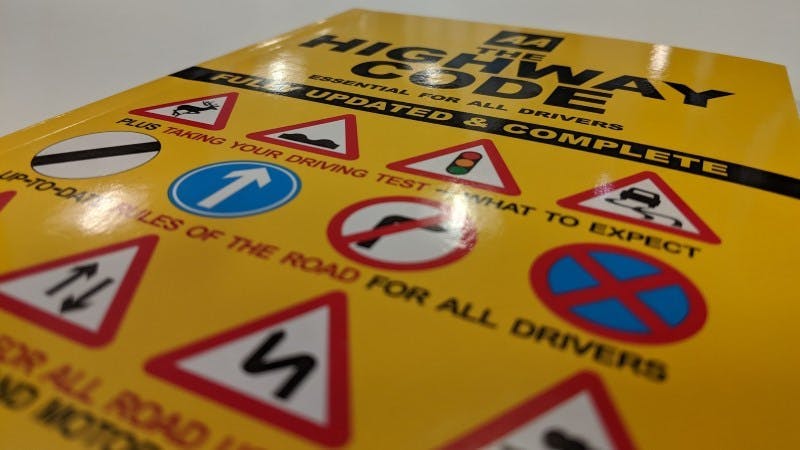
It should come as no surprise to learn that the Highway Code, whose 160 pages cover virtually every aspect of driving, includes rules relating to how motorists should react around animals. It's rule 214 we're most interested in here, which states:
“When passing animals, drive slowly. Give them plenty of room and prepare to stop. Do not scare animals by sounding your horn, revving your engine or accelerating rapidly once you have passed them. Look out for animals being led, driven or ridden on the road and take extra care. Keep your speed down at bends and on narrow country roads. If a road is blocked by a herd of animals, stop and switch off your engine until they have left the road. Watch out for animals on unfenced roads.”
Some of these rules are similar to those which apply when dealing with any type of vulnerable road user: when driving past animals, give them plenty of time and room. You must also, however, take into consideration that animals' reactions are often hard to predict. With this in mind, sudden movements or noises are to be avoided.
While animals may find their way onto the road in any part of the country, rural drivers need to be particularly vigilant for both wild and farm animals. Bushes, shrubs and trees at the side of the road can make it impossible to spot animals about to dart into the road, making it imperative for drivers to maintain a slower speed.
Traffic signs
In some areas, you may see specific traffic signs warning you of the possible presence of certain animals. When you see these signs, you should take appropriate precautions, including reducing your speed, avoiding use of your car's horn, and preparing to stop when necessary. Be sure to familiarise yourself with the following four animal-related traffic signs found in the Highway Code.
Wild animals
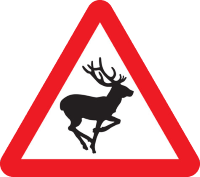
Wild animals

Accompanied horses or ponies
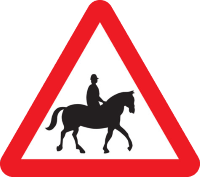
Accompanied horses or ponies

Which animals do I need to watch out for?
Deer
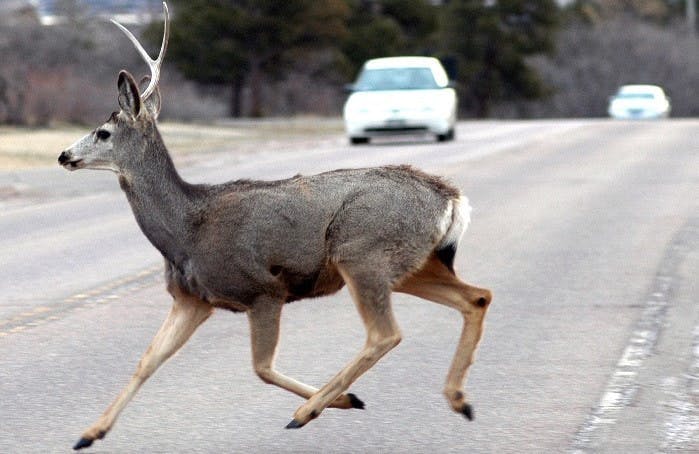
One of the most dangerous wild animals from a driver's perspective is the deer. In 2017, the government estimated a potential annual deer-related toll of 74,000 accidents, with up to 20 predicted deaths. The problem is such that the Deer Aware project was launched in an attempt to tabulate all traffic accidents involving deer.
Most accidents occur during the deer's rutting season, which occurs from around October to December, with dusk and dawn being high-risk times of day. It's also worth noting that this is not a strictly rural problem. Findings reported in a 2011 BBC article showed that many hotspots were inside the M25, and that around a quarter of collisions took place within 50 miles of central London.
Highways England offers motorists plenty of advice on how to stay safe around deer on the roads:
- Slower speeds and increased vigilance in areas close to woods and forests are important, as well as when you see deer warning signs.
- In such areas, use full beam headlights, but dip them when you see deer to make sure they don't freeze.
- Be prepared to stop, and try not to suddenly swerve. Use your hazard warning lights if you need to stop.
- When you see a deer, be aware that more may follow.
- Don't approach an injured deer, as you may put yourself in danger.
Horses
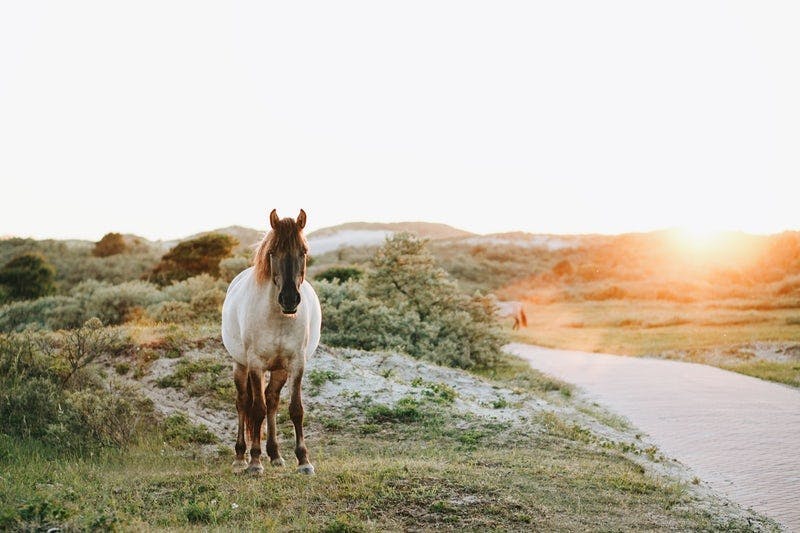
Unlike deer, whose incursions onto the roads are often unexpected, horses are a familiar sight for drivers across the UK. As a result, the Highway Code offers specific advice on driving past horse riders and horse-drawn vehicles in rule 215:
“Be particularly careful of horse riders and horse-drawn vehicles especially when overtaking. Always pass wide and slowly. Horse riders are often children, so take extra care and remember riders may ride in double file when escorting a young or inexperienced horse or rider. Look out for horse riders' and horse drivers' signals and heed a request to slow down or stop. Take great care and treat all horses as a potential hazard; they can be unpredictable, despite the efforts of their rider/driver.”
The last point of rule 215 is particularly salient. While we may be tempted to think of horses as a 'tame' animal, their behaviour is often difficult to predict even when they're accompanied by a rider. The British Horse Society, meanwhile, received reports of 2,900 horse-related road incidents between November 2010 and March 2018. One in five of these incidents involved collisions, resulting in 39 riders and 230 horses being killed.
In response, the society has launched the Dead Slow campaign aimed at raising awareness of how to pass horses safely. They recommend:
- Slowing down to no more than 10 mph when you see a horse on the road
- Avoiding sounding the horn or revving the engine
- Leaving at least a car's width when passing the horse, if possible
- Driving away slowly
The AA, meanwhile, notes that horses have a natural instinct to flee when scared, which may result in them suddenly bolting—potentially into the path of a vehicle. In response, they offer additional advice for drivers: avoid other actions which may spook a horse, including splashing them with puddles, and watch out for any signals the rider provides you.
Other animals
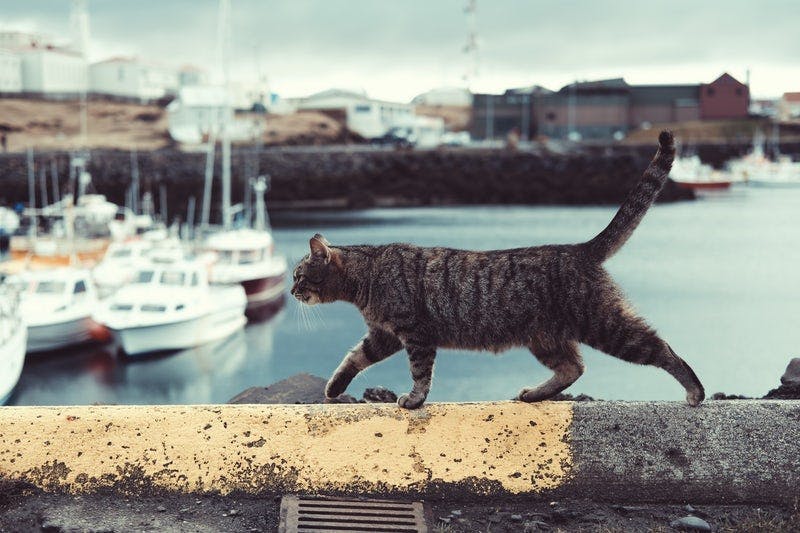
The unpredictable nature of animals on the road means that, sadly, collisions and deaths are always a possibility. Many drivers, however, remain unsure of what to do when they hit an animal. A common trope is that one should stop if you hit a dog, but carry on driving if it's a cat—but is there any truth to this?
The source of this is likely to be the Road Traffic Act 1988. This piece of legislation states that drivers have a duty to stop their car, remain at the scene for long enough to give details to any affected parties, and report incidents to the police within 24 hours. This applies to any road traffic incident where “damage is caused to an animal”, with the exception of animals in the driver's own vehicle or any trailer drawn by it. However, the law also defines which animals drivers must report hitting: horses, cattle, asses, mules, sheep, pigs, goats and dogs.
Legally, then, there is no specific requirement to stop and report incidents involving any other animal. However, organisations such as Cats Protection recommend that owners report collisions with cats to the police, too—and to take them to a vet for emergency treatment if you are able to move them. The police should be able to provide a list of vets offering urgent care in the local area.
If you are involved in a collision with an animal and need to stop your car, use hazard warning lights to warn other traffic.
While it's not always possible to avoid collisions, you can control your own behaviour when driving past animals to make any incidents less likely. So, slow down, keep wide, avoid any sudden actions which may scare an animal, and always be vigilant for any hazard. Following this advice reduces the risk of any nasty accidents—good news for both drivers and our animal friends!
Subscribe for driving advice, offers & more
We'd love to let you know about our courses, news and offers via email. You may unsubscribe at any time.
Star Genie Limited trading as PassMeFast. Company number 10093359
Copyright © 2024 owned by Star Genie Limited
PassMeFast, Blue Tower, MediaCityUK, Salford, M50 2ST

